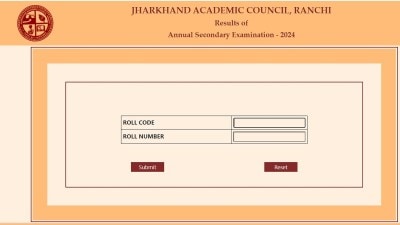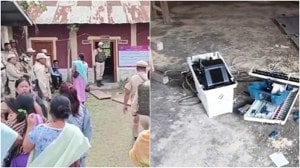- India
- International
Palghar: Spike in moderate malnourishment as six-meals-a-day scheme rolled back
A Palghar district official said they had used District Planning and Development Council’s fund to stretch the six meals up till March after the programme was modified. “But funds exhausted thereafter,” he said.
 Rohit Kirkire (5) has been slipping into moderate malnourishment.
Rohit Kirkire (5) has been slipping into moderate malnourishment.
Five-year-old Rohit Kirkire has been frequently relapsing into moderate acute malnourishment (MAM) over past three years in Nandgaon, a tribal village in Palghar. The local anganwadi fears if the boy degenerates into severe malnourishment, recovery may get difficult.
While the Women and Child Development (WCD) department has launched a ready-to-eat paste for severely malnourished children, little has been done to quell hunger of those moderately malnourished. In fact, a scheme to provide six meals a day to such children was stopped this March in Palghar.
In a letter to Palghar collector Kailash Shinde in July, a district officer had raised concerns that if MAM children continue to further slip into severe acute malnourishment (SAM), their treatment would get difficult. When contacted, collector Shinde maintained that discussion to curb malnutrition was underway. “I am yet to look at this letter,” he said.
 A dilapidated anganwadi in Jawhar. (Express photo)
A dilapidated anganwadi in Jawhar. (Express photo)
Moderate malnourishment, or MAM, is measured through a child’s upper arm circumference taking into account his height and weight according to age. When the mid-arm circumference measurement declines, it indicates severe malnourishment, or SAM. The WCD ran Village Child Development Centres (VCDC) in every anganwadi to provide six meals a day to malnourished children. A year ago, the programme, however, was modified to provide therapeutic processed paste to only SAM children. According to data, since March, when six meals to a MAM child was stopped under the programme, the malnutrition count in Palghar rose from 1,684 in March to 2,396 in June.
A Palghar district official said they had used District Planning and Development Council’s fund to stretch the six meals up till March after the programme was modified. “But funds exhausted thereafter,” he said.

In his thatched-roof hut, Rohit lives with three other siblings. With their father dead and mother out on farms since morning, the children – all aged less than eight – have nothing to eat until she returns in the evening. Rohit manages to have chivda (flattened rice) and khichdi (lentil and rice dish), served at the local anganwadi, but that has not helped improve his nutrition.
“What tribal children, especially those moderately malnourished, need is hot, cooked meals,” Vivek Pandit, who heads Maharashtra’s Tribal Welfare Review Committee, said. During a visit to anganwadis, Pandit found that workers there were also fudging records to show lower malnutrition rates. “A SAM child had gained a kilogram weight as per records, but when we measured his weight, it had in fact declined,” Pandit said. Huge vacancy also adds to the problem — data from March indicates of the 553 sanctioned Child Development Project Officers posts across the state, only 253 posts are filled. With lack of supervision, anganwadi workers have a free hand in handling their centres.
Like Rohit, there are at least eight moderately malnourished children in Kapdichapada village in Jawhar taluka. Anganwadi worker Shakuntala Kuvra, who had to take shelter in one of the gram panchayat’s empty rooms as monsoon fury affected the anganwadi here, said funds are always a problem. “Eggs and bananas, supposed to be distributed four times a week, are not regular in supply,” she added.
At Nandgaon anganwadi of Jawhar taluka, there are two MAM children. Anganwadi worker Surekha Patekar said she has seen no change in both the children with the two meals she serves them every day.
In another Jawhar village, Priyanka Dhore (5) was born underweight, while her elder sister, too, is malnourished. Their mother does not know what malnourishment is and feeds them farm-grown rice along with dal. Priyanka suffers frequent fever and abdominal pain, local anganwadi worker Alka Bhandwe said, adding that unless more nutritious food is provided to the child and she is closely monitored, she cannot recover. “We don’t know what to do with MAM children. We admit them to hospitals if they fall ill,” Bhandwe said.
Across the state there are 97,377 anganwadis with 74,028 severely underweight children and 5.15 lakh moderately underweight children. While the data is from March, sources say, cases are likely to have risen significantly due to the monsoon.
Dr Ramdas Marad, superintendent of Cottage hospital in Jawhar, said if moderately malnourished children are not tackled at anganwadi level, the admissions in hospital’s nutrition rehabilitation centre increases significantly. “Malnourished children are at a higher risk of diarrhoea, fever, cold and gastroenteritis in this season (monsoon). We get about 20 admissions a month at the centre,” Marad said.
Indra Mallo, ICDS commissioner, meanwhile, said the ready-to-use therapeutic paste was working well for SAM children. The paste, he said, is slated to expand to include MAM children as well. Ajay Bhoir, a local health worker from NGO Sathi, however, said the paste was being rejected by several children due to its taste and texture. “These are tribal children, they need local food, not some packaged one.”
Apr 19: Latest News
- 01
- 02
- 03
- 04
- 05






































